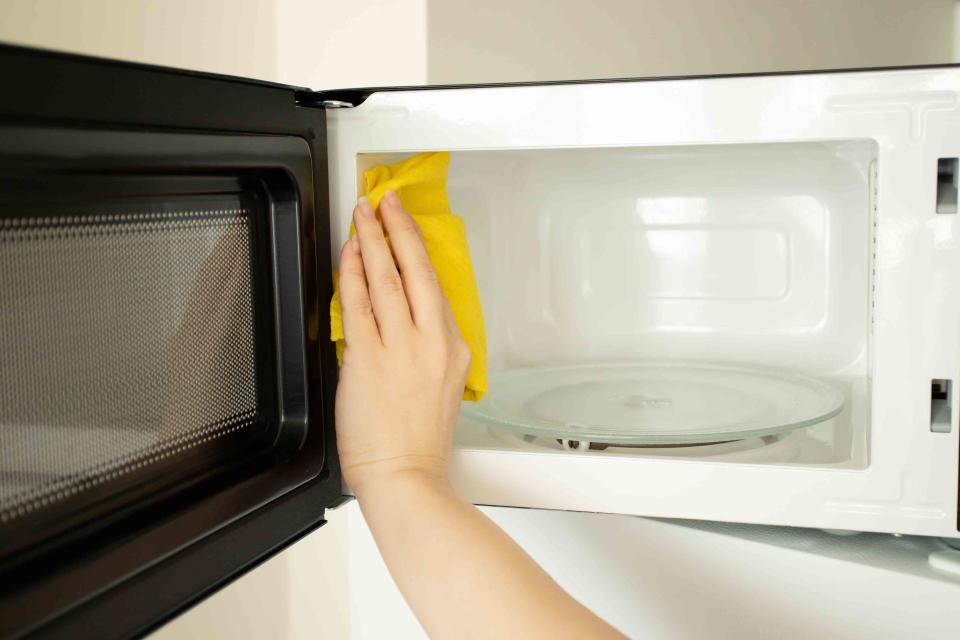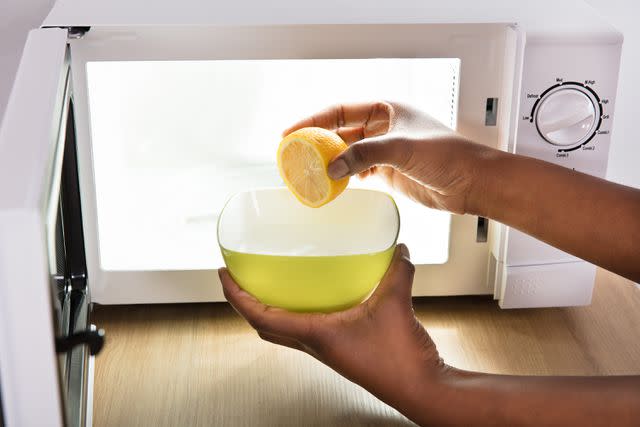3 Easy And Effective Ways To Clean Your Microwave To Remove Stains And Odors
Keep your microwave looking and smelling fresh.

Getty Images / Yana Tikhonova
Potentially the greatest invention of all time, microwaves make our lives so much easier. And considering a lot of us use them almost everyday, it’s really important to keep them clean and well-maintained to keep you and your family healthy and your kitchen looking and smelling clean.
Below, we asked a professional cleaner and an engineer for their advice on how to clean a microwave the right way.
Meet The Expert
Yooshin Kim is Senior Manager of Quality Engineering at LG Electronics.
Jacqueline Stein is a professional cleaner and the owner of Home Reimagined in Austin, Texas.
Why It's Important To Properly Clean Your Microwave
Microwaves can get dirty for a variety of reasons. For example, food heated without any cover can splatter, or crumbs can fall to the bottom of the microwave when pulling food out. “This fallen debris has the potential to interfere with the rollers underneath the turntable, causing them to get stuck,” explains Yooshin Kim, Sr. Manager, Quality Engineering at LG Electronics. “This can result in uneven heating and reducing the efficiencies of the microwave.”
Just like any other item in your home, it’s important to clean your microwave because it will help the device last longer—it should also be done regularly for health and safety reasons, too. “Keeping a clean microwave helps you stay in good health, as you are removing food residue and preventing the growth of bacteria from nasty germs,” explains Jacqueline Stein, a professional cleaner and the owner of Home Reimagined in Austin, Texas. “Remember that you are putting your food inside this appliance, therefore you want to avoid any mold or bacteria that could be touching your food and making you sick.”
To avoid any splatters when microwaving, Stein recommends trying a microwave splatter cover or a paper towel to cover your food when reheating.
Before Getting Started
There are also some safety precautions that you’ll want to consider before cleaning out your microwave. As with any cleaning, Stein suggests protecting yourself by wearing gloves, wearing a mask, and only cleaning in well-ventilated rooms to avoid any inhalation of chemicals. “Plus, when cleaning with hot water or bowls that you may put in the microwave, always handle with caution so as not to burn yourself.”
When cleaning a microwave, Kim advises users to handle the glass turntable with care if it must be removed. When placing the turntable back on its rolling support and base, you should make sure that the turntable is secure so that it can continue to turn normally when in use.
“Heavy duty abrasives, such as steel wool or a heavy duty scrubbing sponge, should not be used inside the microwave, as this can scratch the inner surfaces of the microwave,” warns Kim. “Using something like a damp cloth is a very effective tool to use when cleaning the microwave.” Stein also advises using “food-safe” cleaning solutions, so no chemicals get into your food when heating it.
Related: How To Clean A Kitchen Sink
What You’ll Need
Microwave-safe bowl
Vinegar
Lemon
Dish soap
Baking soda
Water
Damp, non-scratch sponge or cloth
Oven mitts
How To Clean a Microwave
Method 1: Vinegar and Water
Mix equal parts distilled white vinegar and water into a microwave safe bowl.
Place bowl into the microwave and heat it on high for 3-5 minutes to create steam in the microwave that will loosen up the stuck-on gunk.
Once the microwave has stopped, let the bowl stand for 1-2 minutes before removing. Remember that it will be hot, so use oven mitts to grab it for safety.
Use a damp, non-scratch sponge, and easily wipe down the inside of the microwave. The gunk should easily wipe off with minimal scrubbing.
After it has cooled completely, you can remove the glass plate at the bottom, if needed, and hand wash it in the sink.
Method 2: Lemon Juice and Water
Fill a microwave safe bowl with water.
Cut a lemon open and squeeze ½ to 1 whole lemon juice into the same bowl and mix. You can also add 1 tablespoon of dish soap, if you have very bad build up in the microwave.
Place bowl into the microwave and heat it on high for 3-5 minutes to create steam in the microwave that will loosen up the stuck-on gunk.
Once the microwave has stopped, let the bowl stand for 1-2 minutes before removing. Remember that it will be hot, so use oven mitts to grab it.
Use a damp, non-scratch sponge, and easily wipe down the inside of the microwave.
After it has cooled completely, you can remove the glass plate at the bottom and hand wash it.

Getty Images / AndreyPopov
Method 3: Baking Soda and Water
Mix 2-3 tablespoons of baking soda into a microwave-safe bowl and add water.
Place bowl into the microwave and heat it on high for 3-5 minutes to create steam in the microwave that will loosen up the stuck-on gunk.
Once the microwave has stopped, let the bowl stand for 1-2 minutes before removing. Remember that it will be hot, so use oven mitts to grab it for safety.
Use a damp, non-scratch sponge, (or damp microfiber towel for baking soda) and easily wipe down the inside of the microwave. The gunk should easily wipe off with minimal scrubbing.
After it has cooled completely, you can remove the glass plate at the bottom, if needed, and hand wash it in the sink.
How Often To Clean Your Microwave
Most experts will recommend cleaning it once a week, but if you are using a splash guard or do not use it as often, you could go every other week and still be keeping it clean.
Frequently Asked Questions
Can I use other cleaning products instead of vinegar, lemon juice, or baking soda?
You could use some commercial cleaners that are safe for microwaves, but Stein suggests only using those that are natural and labeled as “food-safe” to avoid any of the product touching your food. “To avoid damage, do not use any tough scrub brushes or products that can get stuck in the holes or vents of the microwave,” says Stein.
How do I remove burnt-on stains from the microwave?
According to Kim, it is difficult to remove burnt-on stains from the microwave, but the best option is to prevent them from happening at all. “Microwave-safe covers can be used to prevent splatter stains inside the microwave,” he says. “However, if burnt-on stains do occur, a non-abrasive cleaning sponge, scrubber, or towel can be used with some mild soapy water.” Stein also suggests making a paste of baking soda and water and placing it on the stains to sit for up to 10 minutes before scrubbing with a non-scratch sponge to remove.
Can I clean the microwave with bleach?
Undiluted bleach is not recommended for cleaning microwaves. “This solution causes dangerous fumes, as well as damages surfaces,” warns Kim. “If the users absolutely wants to use bleach to disinfect, they should heavily dilute the bleach with water—as a tip, never mix bleach with vinegar.”
Related: 12 Things You Should Never Do When Cleaning Your Kitchen
For more Southern Living news, make sure to sign up for our newsletter!
Read the original article on Southern Living.

